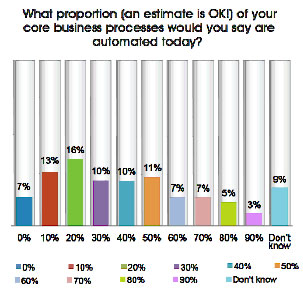This briefing in AIIM’s Digital Landfill: Overcoming Information Chaos was first published on August 27, 2018, and written by John Mancini, Chief Evangelist at AIIM International. An excerpt is provided here.
Tactics to Consider
Digital transformation can mean different things to different organizations. For some, it might mean taking the first steps to reduce the dependency on paper and manual workflow. This makes sense, since going “paperless” is a valuable effort where you’ll easily see a return on your investment. But in these competitive times, I believe that organizations need to look further…beyond simply “scan and store.”
That is the subject of a recent AIIM webinar called “Digital Darwinism – Real Digital Transformation for Your Automation Projects” now available ondemand. Doculabs analyst Richard Media and Parascript VP of Marketing and Product Management Greg Council explore how the processes that are most ripe for automation are those requiring a bit more thought.
Trends Toward Process Automation
We see this trend holding true in our research. We recently surveyed 152 AIIM member companies for an AIIM Industry Watch report called “Digitalizing Core Business Processes” and found that 75% of organizations that we spoke with view process automation as “important” or “very important” to their organization.
However, most (67%) report having less than half of their processes automated. On average, only 36% of processes are automated.

As Charles Darwin once famously said, “In the long history of humankind (and animal kind, too) those who learned to collaborate and improvise most effectively have prevailed.” I believe that to prevail today organizations must devise new ways of working that intensify collaboration and improvisation (e.g., innovation); and that means evolving beyond simply being “paperless.”
How can you do that? Here are three transformational tactics to consider.
ANALYZE.
For many, “digitization” tends to imply scanning a piece of paper and filing away an image file. What is needed today is a much more expansive approach. You could be entirely paperless, but still miss the broader opportunity to leverage information in a way that is increasingly more beneficial to the performance of the organization.
This begins by analyzing your documents beyond simply identifying rudimentary data elements like type, date, account number and customer name. Techniques like advanced text analytics, for example, now provide approaches that work to bring textual content to a point where it can be represented as data and then mined for insights, trends and patterns. That insight can then be used strategically, to optimize product development, boost customer service or improve any number of transactional processes and workflow. This is something entirely more far-reaching than just simply packing away a scan in a file folder somewhere.
IDENTIFY.
After you analyze your documents the next step is to identify the opportunity they present. How can the information and insight be used to fuel the improvement of key business processes and power more informed decision-making and strategy design? This is at the heart of business intelligence. The value is in enabling organizations with the ability to not only collect data, but also to make more sense of it in more thoughtful and profitable ways. After all, we can collect all the information we want, but the information we collect is only as valuable as the insight that it provides. And gaining that insight starts with identifying the opportunities: What information do we have? What is its value to the organization? And how can that information be used to further our performance?
EXTRACT.
Organizations that are most successful in leveraging digital transformation are those that work to integrate data, documents and process workflow with systems that are geared to prepare data for analysis, run queries against the information, and make the results available to decision makers in ways that make a real difference. The key is extracting data and injecting it into a business process without a lot of manual intervention and with a fair degree of “intelligence.”
Advanced techniques like robotic process automation work to streamline the process to classify, locate, extract and verify data. Automated document mapping techniques and self-learning software make the extraction and use of information much easier and more complete than ever before and could be your secret weapon to “digitalizing” core business processes.
In the Real World
In what practical ways can you use these tactics as you evolve in the age of digital transformation? Companies participating our research point to fairly traditional back-end operations as prime targets. These include processes like internal reviews and approvals (48%), HR processes (36%), sales processes and contracts (34%), customer correspondence (32%), and finance (29%).
If you thought digital transformation was about getting rid of paper, you’d only be partially right. To take full advantage of the evolution you have to leverage the data within those documents – and automate how documents are received, identified, and used – in order to remain competitive in this evolving era of digital transformation.
# # #
If you found this briefing useful, perhaps you will find this webinar of interest:

